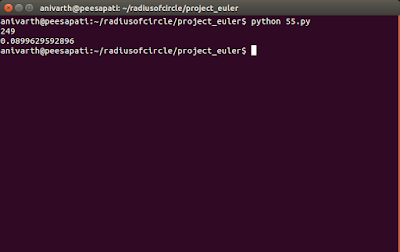Lychrel numbers
If we take 47, reverse and add, 47 + 74 = 121, which is palindromic.
Not all numbers produce palindromes so quickly. For example,
Although no one has proved it yet, it is thought that some numbers, like 196, never produce a palindrome. A number that never forms a palindrome through the reverse and add process is called a Lychrel number. Due to the theoretical nature of these numbers, and for the purpose of this problem, we shall assume that a number is Lychrel until proven otherwise. In addition you are given that for every number below ten-thousand, it will either (i) become a palindrome in less than fifty iterations, or, (ii) no one, with all the computing power that exists, has managed so far to map it to a palindrome. In fact, 10677 is the first number to be shown to require over fifty iterations before producing a palindrome: 4668731596684224866951378664 (53 iterations, 28-digits).
Surprisingly, there are palindromic numbers that are themselves Lychrel numbers; the first example is 4994.
How many Lychrel numbers are there below ten-thousand?
Not all numbers produce palindromes so quickly. For example,
349 + 943 = 1292,
1292 + 2921 = 4213
4213 + 3124 = 7337
That is, 349 took three iterations to arrive at a palindrome.1292 + 2921 = 4213
4213 + 3124 = 7337
Although no one has proved it yet, it is thought that some numbers, like 196, never produce a palindrome. A number that never forms a palindrome through the reverse and add process is called a Lychrel number. Due to the theoretical nature of these numbers, and for the purpose of this problem, we shall assume that a number is Lychrel until proven otherwise. In addition you are given that for every number below ten-thousand, it will either (i) become a palindrome in less than fifty iterations, or, (ii) no one, with all the computing power that exists, has managed so far to map it to a palindrome. In fact, 10677 is the first number to be shown to require over fifty iterations before producing a palindrome: 4668731596684224866951378664 (53 iterations, 28-digits).
Surprisingly, there are palindromic numbers that are themselves Lychrel numbers; the first example is 4994.
How many Lychrel numbers are there below ten-thousand?
A big question, but easy problem. It just took five minutes for me to write the code. The code is very simple. Algorithm for this problem is as follows:
1) Create a function to check if the number is Lychrel number or not. You can do that as follows:
- Start looping, and for each iteration check if sum of the number and its reverse will form a palindrome or not. If the number is found to be a palindrome stop looping and return False.
- If in the current iteration the value of the number is not found to be a palindrome then change the number to the sum of the number and its reverse and continue iterations.
That's it. Have a look at the program and I am sure you will understand it easily.
Program
We have used slicing operation to reverse the string in python and then compare it with the main number.
You can download the source code from Github Gist pep55.py
Output
Summary
At the moment I just want to tell you that I am satisfied with the code I have written. I liked this problem also.Please correct me if my grammar is wrong or in an ambiguous way.
Comment in the comment box below if you have any doubt or haven't understood anything. I will be glad to help you.
Please do comment in the comment box below, if you have found any typo or have a different program or have a better program or have any suggestion. I will be very happy to view each of them.
You can also contact me.
Thank you. Have a nice day😃!

